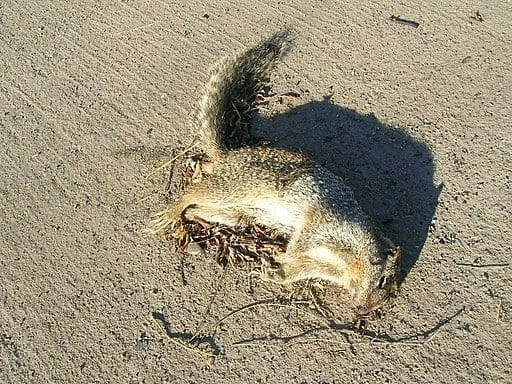The first thing that you need to do if your dog eats any part of a dead animal, squirrel or otherwise, is to contact your vet.
It might seem like an awkward conversation when you call your vet and tell them, “Uhhh…. My dog ate a dead squirrel….”, but they are the ones that can let you know precisely what you need to look out for and if you need to bring them in to get checked out.
When you call, you need to give them as much information as possible, like what kind of animal they ate, how long it’s been dead, where you found the dead animal, and any other pertinent information.
And don’t worry, dogs eating dead animals isn’t as rare as you’d think!
Things to Watch Out For
Several parasites can infect your dog if they eat a dead squirrel. While there are a wide range of parasites it can get if your dog has eaten dead animals, roundworm and coccidiosis are the two most common.
Roundworm

According to the Animal Humane Society, roundworm is the most common type of intestinal parasite in both dogs and cats. Adult roundworms are between two and six inches long.
They live off food in the intestinal tract of your pet, and this can lead to your pet struggling to get the nutrients that they need.
While they tend to live in the intestinal tract, they can migrate their way throughout your pet’s body.
Most de-wormers can kill them, but multiple treatments are often needed. Signs of roundworm include lethargy, diarrhea, vomiting, and a pot-bellied appearance.
Coccidiosis

Your pet is most likely to contract coccidiosis by exposure to another infected dog’s feces.
However, if your animal is eating small rodents, like squirrels, they will contract the parasite if the animal they are consuming was infected.
PetMD states that coccidiosis is highly contagious from pet to pet, so if you have multiple animals living in the same household, it will make all of your dogs sick if you don’t get it under control quickly.
The most common symptom of coccidiosis is watery diarrhea. If left untreated, this will progress to a bloody stool, and your pet will be unable to hold it, leading to more accidents throughout your home.
My Dog Ate a Dead Squirrel: The Worst Case Scenario

While those parasites might be a headache, it’s not the worst-case scenario.
The worst-case scenario is if your pet eats a poisoned animal.
How dangerous secondary poisoning is will depend on the original toxicity of the poison and how much of the animal was eaten.
According to the Pet Poison Helpline, signs of poisoning include diarrhea, vomiting, loss of appetite, nausea, vomiting or coughing of blood, jaundice, and excessive thirst or urination.
If you suspect that your pet’s been poisoned, contact your vet immediately. The sooner your pet gets treated, the more likely that you will have a positive outcome.
What Else Might My Dog Eat That He Shouldn’t?
Right now, you might be asking yourself, “Today my dog ate a dead squirrel, tomorrow he might eat something else he shouldn’t.”
You’re completely right.
That’s why it’s important to know what else to keep an eye out for now that you know your dog likes to eat things that he shouldn’t.
Animal Concerns
If your pet ate a dead squirrel, any animal that they come across might look like a tasty treat.
You should try to keep your pet from eating any animal, dead or alive. All animals carry the risk of parasites and other diseases that your pet might get by eating them.
Furthermore, some animals might do more damage than others if your pet tries to eat them.
Squirrels themselves have long, hard teeth and may bite back if provoked by an inquisitive snout.
Depending on where you live, snakes, porcupines, hedgehogs, foxes, bees, and spiders might be an even more significant concern than squirrels.
Foreign Object Concerns
If your dog likes to chew things, foreign objects can be a significant concern. Kid’s toys, scented candles, wood, and even rocks are just objects that you need to look out for when your pet is outside.
Ensuring that your pet doesn’t eat these objects is about more than preventing damage to toys and property. When your pet consumes these items, you have to look out for a wide range of problems. From intestinal blockages to internal punctures and bleeding, there are a litany of issues that can arise from your pet eating non-food objects.
If you suspect that your pet is having any of these problems, you must seek a vet IMMEDIATELY. These problems can lead to your pet dying within 24 hours if left untreated.
Plant Concerns
If your pet has a history of eating things they shouldn’t, then you need to be careful about what plants you have around.
If your dog ate a dead squirrel, then chances are there were a few acorns lying around too. It is dangerous for dogs too eat too many acorns, as they contain a chemical called gallotannin that can eventually lead to kidney failure.
There are a wide variety of common household plants that are toxic to dogs if they eat them.
Some examples include tulip bulbs, hydrangeas, ivy, daffodil bulbs, and sweet pea. For a comprehensive list of plants, check out the list provided by the ASPCA. The listing includes over 1,000 common household plants and will let you know if they are toxic to your pet or not.
How Do I Train My Dog Not to Eat Things They Shouldn’t?

Of course, it’d be easier if your pet just didn’t eat things they shouldn’t.
One of the easiest ways to train your pet not to eat something they shouldn’t is to send them to obedience school.
There are a wide range of programs, some will take your pet and train them thoroughly, and others will teach you tips and tricks to help you out.
If you aren’t looking to send your dog to obedience school, there are some things you can try at home.
The easiest thing you can do is bring treats with you when you go out for walks. If your dog sees something that they want to try and eat, you can distract them with the treats.
Another way that you can train your dog not to eat things they shouldn’t is to teach them with the ‘drop it’ or ‘leave it’ game.
You can do this by firstly holding a toy with one hand, and a treat with the other. Make sure that the treat is hidden in an enclosed fist.
Get your dog to become interested in the toy and allow it to bite onto the toy. When your dog’s full attention is on the toy, reveal the treat to him.
Gently but firmly prompt your dog with “Drop it” or “Leave” to get them to let go of the toy and come to the treat. When they do this successfully, reward them with the treat quickly.
Even after you train your dog, never take for granted that your pet won’t eat things that they shouldn’t.
Always keep an eye on your pet, and make sure they get any help that they need if they end up eating something that they shouldn’t.
In Conclusion
Dogs aren’t picky eaters, and as such it’s not as uncommon as you might think for them to eat dead animals they encounter, such as squirrels.
Other than being unsavory, your dog could pick up unwanted parasites and diseases from eating dead flesh. These can include roundworms and coccidiosis. However, the biggest risk is the secondary poisoning that could occur if the squirrel also died from eating something toxic.
Generally, over the next few days keep an eye on your dog for symptoms such as diarrhea, vomiting, bloody stools and loss of appetite. If it shows any of these signs, take it to the vet for professional assessment.
The best way to prevent your dog from eating dead animals in the future is to train it thoroughly. You can either do this by taking it to obedience school, or doing exercises at home that train their command-following ability and impulse control.
Heather Abraham is a professional blogger who owns two dogs, a cat, a parrot, and a leopard gecko. She has a connection with animals since she was a child. She shares her love for all pet breeds and provides information on pet food, toys, medications, beds, and everything else.
She is committed to learning about the internal workings of animals. Her work permits her to work closely with knowledgeable vets and obtain practical expertise in animal care. When she is not working, her love of animals continues in her writing. Her goal is to educate and uplift readers who also have a passion for animals through her writing.
